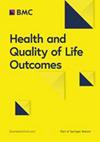采用 EQ-5D-5L 衡量输血依赖型 β 地中海贫血症患者健康相关生活质量的适当性:一项混合方法研究
IF 3.4
2区 医学
Q1 HEALTH CARE SCIENCES & SERVICES
引用次数: 0
摘要
输血依赖型β地中海贫血(TDT)患者会出现一些症状和功能性影响,从而降低了他们的健康相关生活质量。然而,从 EQ-5D 得出的 TDT 健康效用指数得分往往表明其 HRQoL 良好,这表明 EQ-5D 可能无法充分反映 TDT 的影响。本研究探讨了 TDT 的疾病和治疗负担,并研究了 EQ-5D-5L 描述系统 (DS) 在测量 TDT 患者 HRQoL 方面的适宜性。英国、美国和法国的成人 TDT 患者填写了一份背景调查问卷和 EQ-5D-5L DS,然后就 TDT 的症状和 HRQoL 影响(概念激发)以及 EQ-5D-5L DS 的适当性(认知汇报)进行了 60 分钟的半结构化访谈。通过主题分析和内容分析对访谈记录进行了分析。在概念模型中总结了 TDT 症状与影响之间的关系。将 EQ-5D-5L DS 与定性数据中确定的概念进行映射,以评估其对 HRQoL 概念的捕捉。将参与者的 EQ-5D-5L DS 分数与他们对每个维度的定性描述进行比较,以评估两者的一致性。美国(n = 14 [46.7%])、英国(n = 12 [40.0%])和美国(n = 14 [46.7%])的 30 名参与者进行了对比。(n = 12 [40.0%])和法国(n = 4 [13.3%])的 30 名参与者完成了研究(73.3% 为女性;平均年龄 = 28.4 岁 [标准差 (SD) = 5.1];平均每年输注红细胞 [RBCT] 频率 = 18.4 [SD = 7.6])。参与者报告的 TDT 症状和对 HRQoL 的影响在整个 RBCT 周期内均有波动。在报告的 16 个 HRQoL 概念中,有 11 个(68.8%)的 EQ-5D-5L DS 没有完全捕捉到。大多数参与者(n = 20/27 [74.1%])表示,EQ-5D-5L DS 没有反映出 TDT 患者生活的重要方面,42.9% 的参与者(n = 12/28)对 EQ-5D-5L DS 的总体印象为负面/中性。参与者的定性数据与 EQ-5D-5L DS 维度得分不一致程度最高的是行动能力(42.3%)和自我护理(34.6%),这两个维度的定性描述比定量得分更差。目前的研究结果表明,EQ-5D-5L DS 缺乏内容有效性,得出的健康效用指数得分可能不能完全代表 TDT 的疾病负担。本文章由计算机程序翻译,如有差异,请以英文原文为准。
Appropriateness of the EQ-5D-5L in capturing health-related quality of life in individuals with transfusion-dependent β-thalassemia: a mixed methods study
Individuals with transfusion-dependent β-thalassemia (TDT) experience symptoms and functional impacts that reduce their health-related quality of life. However, EQ-5D-derived health utility index scores in TDT often indicate good HRQoL, suggesting the EQ-5D may not adequately capture the impact of TDT. This study explored the disease and treatment burden of TDT and examined the appropriateness of the EQ-5D-5L descriptive system (DS) in measuring HRQoL in TDT. Adults with TDT in the United Kingdom, United States, and France completed a background questionnaire and EQ-5D-5L DS, followed by 60-minute semi-structured interviews on symptoms and HRQoL impacts of TDT (concept elicitation) and appropriateness of EQ-5D-5L DS (cognitive debrief). Transcribed interviews were analyzed using thematic and content analyses. The relationship between TDT symptoms and impacts were summarized in a conceptual model. EQ-5D-5L DS was mapped to concepts identified in the qualitative data to assess its capture of HRQoL concepts. Participants’ EQ-5D-5L DS scores were compared to their qualitative descriptions for each dimension to assess their concordance. Thirty participants in the United States (n = 14 [46.7%]), United Kingdom. (n = 12 [40.0%]), and France (n = 4 [13.3%]) completed the study (73.3% female; mean age = 28.4 years [standard deviation (SD) = 5.1]; mean annual red blood cell transfusion [RBCT] frequency = 18.4 [SD = 7.6]). Participants reported TDT symptoms and impacts on HRQoL, all fluctuating across the RBCT cycle. EQ-5D-5L DS did not fully capture 11 of 16 (68.8%) HRQoL concepts reported. Most participants (n = 20/27 [74.1%]) reported that EQ-5D-5L DS did not capture important aspects of living with TDT, and 42.9% (n = 12/28) reported negative/neutral overall impressions of EQ-5D-5L DS. The highest degree of discordance between participants’ qualitative data and EQ-5D-5L DS dimension scores was observed with mobility (42.3%) and self-care (34.6%), where the qualitative descriptions relating to these dimensions were worse than their quantitative scores. Current findings suggest that EQ-5D-5L DS lacks content validity and the derived health utility index score may not fully represent the burden of disease in TDT.
求助全文
通过发布文献求助,成功后即可免费获取论文全文。
去求助
来源期刊
CiteScore
7.30
自引率
2.80%
发文量
154
审稿时长
3-8 weeks
期刊介绍:
Health and Quality of Life Outcomes is an open access, peer-reviewed, journal offering high quality articles, rapid publication and wide diffusion in the public domain.
Health and Quality of Life Outcomes considers original manuscripts on the Health-Related Quality of Life (HRQOL) assessment for evaluation of medical and psychosocial interventions. It also considers approaches and studies on psychometric properties of HRQOL and patient reported outcome measures, including cultural validation of instruments if they provide information about the impact of interventions. The journal publishes study protocols and reviews summarising the present state of knowledge concerning a particular aspect of HRQOL and patient reported outcome measures. Reviews should generally follow systematic review methodology. Comments on articles and letters to the editor are welcome.

 求助内容:
求助内容: 应助结果提醒方式:
应助结果提醒方式:


